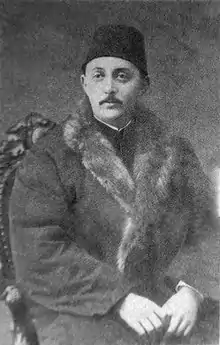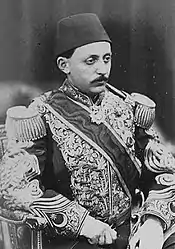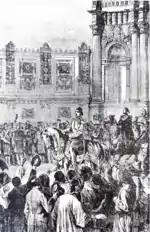Murad V
Murad V (Ottoman Turkish: مراد خامس; Turkish: V. Murad; 21 September 1840 – 29 August 1904) was the 33rd Sultan of the Ottoman Empire who reigned from 30 May to 31 August 1876.
| Murad V مراد خامس | |||||
|---|---|---|---|---|---|
| Ottoman Caliph Amir al-Mu'minin Kayser-i Rûm Custodian of the Two Holy Mosques | |||||
 | |||||
| 33rd Sultan of the Ottoman Empire (Padishah) | |||||
| Reign | 30 May 1876 – 31 August 1876 | ||||
| Predecessor | Abdulaziz | ||||
| Successor | Abdul Hamid II | ||||
| Born | 21 September 1840 Çırağan Palace, Istanbul, Ottoman Empire (present day Istanbul, Turkey) | ||||
| Died | 29 August 1904 (aged 63) Çırağan Palace, Istanbul, Ottoman Empire | ||||
| Burial | 30 August 1904 New Mosque, Istanbul | ||||
| Consorts | |||||
| Issue | |||||
| |||||
| Dynasty | Ottoman | ||||
| Father | Abdulmejid I | ||||
| Mother | Şevkefza Kadın | ||||
| Religion | Sunni Islam | ||||
| Tughra |  | ||||
Early life
Murad V was born as Şehzade Mehmed Murad[1] on 21 September 1840[2] in the Çırağan Palace[3] in Istanbul.[4] His father was Sultan Abdulmejid I, son of Sultan Mahmud II and Bezmiâlem Sultan. His mother was Şevkefza Kadın, an ethnic Circassian[5] from the Ubykh tribe, daughter of Mehmed Bey Zaurum and his wife Cemile Hanım.[6]
In September 1847,[7] aged seven, he was ceremoniously circumcised together with his younger half-brother, Şehzade Abdul Hamid.[8][9]
Murad was educated in the palace. His tutors included Toprik Süleyman Efendi, who taught him the Quran, Ferrik Efendi, who taught him Ottoman Turkish language, Sheikh Hafız Efendi, who taught him Hadith (the traditions of Muhammad), Monsieur Gardet, who taught him French, and Callisto Guatelli and Italian Lombardi, who taught him to play piano.[10][11]
Crown prince

After Abdulaziz assended the throne after the death of Sultan Abdulmejid in 1861, Murad became the heir to the throne. He spent most of his time at his farmhouse in Kurbağalıdere which Abdulaziz had allocated to him. His family used to spend their winters in the crown princes apartments located in the Dolmabahçe Palace and the Nisbetiye Mansion.[12][13]
He participated in the visits of Abdulaziz to Egypt in 1863 and to Europe in 1867. While he was appreciated by the European rulers with his kindness, his uncle, who was uncomfortable with this, had planned to send him back to Istanbul. Napoleon III and Queen Victoria, showed interest in Murad more than Abdulaziz. Moreover, special invitations and excursions were organized for the crown prince.[14]
He frequently spoked with the New Ottomans, who wanted a constitutional regime. Şinasi, whom he met frequently, exchanged ideas with Namık Kemal Bey and Ziya Pasha on constitutionalism, democracy and freedom. Through Ziya Pasha and his private doctor Kapoleon Efendi, he also communicated with Midhat Pasha, the leader of the opposition group, who was dissatisfied with Sultan Abdulaziz's rule.[15]
Murad was the first member of the Ottoman dynasty to become a member of the Grand Lodge of Free and Accepted Masons of Turkey.[16] On 20 October 1872,[17] Murad was secretly inducted into the lodge, sponsored by his chamberlain Seyyid Bey. Murad rose through the ranks in the lodge. At one point he proposed establishing an independent Ottoman lodge to be named Envar-ı Şarkiye, “Eastern Lights,” with its ritual conducted in Turkish, but the plan was never realized.[18]
Succession question
Sultan Abdulaziz tried to change the succession system in favor of his own son Şehzade Yusuf Izzeddin.[19] For this purpose Abdulaziz set out to mollify different pressure groups and have his son gain popularity among them. During the 1867 visit to Europe, rumors spread that contrary to the rules of protocol Abdulaziz arranged Izzeddin's reception in Paris and London before the official heir, Prince Murad. When the conservative Mahmud Nedim Pasha became the Grand vizier in September 1871 he lent his support to Abdulaziz's plans.[20] To further legitimize his plans, Abdulaziz tactically supported a change to primogeniture in the Muhammad Ali dynasty of Egypt. By granting primogeniture to Isma'il Pasha in 1866, Abdulaziz was clearly seeking to create a positive climate of opinion about a change in favour of his own son.[21]
Reign

Accession
As a result, Murad cooperated with the constitutionalist circles and took part in the deposition of Abdulaziz.[19] On the night of 29–30 May 1876, the committee led by the statesman Midhat Pasha, the leading statesman of the Ottoman Tanzimat era, and the Minister of War, Hüseyin Avni Pasha, deposed Abdulaziz and raised Murad to the throne.[2]
Though he successfully acceded to the throne, he was not capable of maintaining his place.[19] He struggled to appear normal in his new role, so at odds with his previously quiet life of dabbling in music.[2] His weak nerves, combined with alcoholism, led to a mental breakdown.[19] But the death of his deposed uncle only days after his accession stunned him. The distress over the abrupt manner in which he was brought to the throne, and the demands besieging him as ruler was the anxiety that the world would assume he had ordered his uncle's murder.[2]
Illness and deposition
Murad began to manifest bizarre behavior that preceded his complete collapse. The government leaders called in the Viennese specialist in psychiatric disorders, Dr. Max Leidesdorf, who concluded that the new Sultan could make a complete recovery with three months' treatment in a clinic. This the government leaders were unwilling to attempt. A mentally competent prince on the throne formed an essential component of their plans to implement reforms with due legitimacy. Murad’s younger brother and heir to the throne, Abdul Hamid, however, appeared eminently healthy physically and mentally, and supportive of the leaders' plans to introduce parliamentary government.[22]
Securing the Şeyhülislam's ruling sanctioning Murad's dethronement, and Abdul Hamid's promise to proclaim a constitution,[23] Midhat Pasha, and the Ottoman governing deposed him on 31 August 1876,[19] after reigning for only ninty-three days on the grounds that he was mentally ill.[24] After which his younger half-brother, Sultan Abdul Hamid II, ascended the throne. Murad was then confined to the Çırağan Palace, which Abdul Hamid didn't allowed him to leave.[19]
Confinement

In confinement, Murad's consort Gevherriz Hanım worked with Nakşifend Kalfa, the hazinedar Dilberengiz, the eunuch Hüseyin Ağa, and Hüsnü Bey (who had been Second Secretary of Murad) to allow for a British doctor to meet with Murad to ascertain Murad's mental fitness. When the doctor arrived, Gevherriz served as translator. It is not clear how true this story is, and it is possible the doctor was sent by freemasons rather than by the British.[25]
Some nine months into confinement, Murad regained his mental faculties. The first two years of his confinement in Çırağan witnessed three attempts by supporters to free him and restore him to the throne, but all three resulted only in Abdul Hamid’s tightening the cordon that isolated Çırağan Palace from the city around it.[23]
Ali Suavi incident
On 20 May 1878,[26] an attempt was made to liberate Murad from the Çırağan Palace and restore him to the throne. Murad’s brothers, Şehzade Ahmed Kemaleddin and Şehzade Selim Süleyman, and sisters, Fatma Sultan and Seniha Sultan, and her husband Mahmud Celaleddin Pasha were involved in the plot.[27] They all wanted to see the rightful Sultan on the throne.[26] During the incident Ali Suavi, the radical political opponent of Abdul Hamid’s authoritarian regime stormed the palace with a band of armed refugees from the recent Russo-Turkish War (1877–1878).[26] Ottoman battleship Mesudiye was anchored offshore the palace to take Murad, and to announce his accession.[28] However, he didn't reached the battleship,[29] Ali Suavi's men were unable to overcome the fierce resistance of the Beşiktaş police prefect, Hacı Hasan Pasha.[30] The plot failed, and Ali Suavi and most of his men were killed.[31] In the aftermath, security at the Çırağan Palace was tightened.[32]
Life in confinement
.jpeg.webp)
His mental faculties restored, Murad lived out a far more benign existence than that attributed to him by the Western press. Reports through the years claimed that the former Sultan languished in prison, or escaped and was hiding, or lectured his brother on the Armenian troubles.[23]
After his mother's death in 1889, Murad focused all his love and attention on his children. Selaheddin became his companion in grief, and the two of them passed long hours together reminiscing about bygone days as well as speculating on the future. For some time father and son took an interest in the Mesnevi, spending hours reciting verses from that work and taking great pleasure in doing so.[33]
Death and legacy
.jpg.webp)
At length, suffering from diabetes, Murad died at the Çırağan Palace on 29 August 1904.[23] While his senior consort Mevhibe Kadın, and his son Selahaddin reported that Murad was willing to be buried in the mausoleum of Yahya Efendi, however, Abdul Hamid, didn't approved of it. The next day, Murad's funeral was carried out without announcement and ceremony. His body was washed and shrouded in the Topkapı Palace, and was then taken to the Hidayet Mosque in Bahçekapı. After the funeral procession was held, he was buried next to his mother Şevkefza in the New Mosque, Istanbul.[34]
An important primary source about his life comes from the memoirs of one of his consorts, Filizten Hanım, written in the 1930s.[35]
Personality
Murad had learned both French and Arabic. He ordered and read books and magazines from France and was influenced by French culture. He played the piano, composed Western-style music.[19] He was also a liberal.[24][36][37][38]
Honours
- Order of the Medjidie, Jeweled, 23 February 1867[12]
Issue
| Name | Birth | Death | Notes |
|---|---|---|---|
| By Mevhibe Kadın (married 2 January 1857; c. 1844 – c. 1936) | |||
| no issue | |||
| By Reftarıdil Kadın (married 4 February 1859; c. 1839 – c. 1936) | |||
| Şehzade Mehmed Selaheddin | 5 August 1861[39][40] | 29 April 1915[39][40] | married seven times, and had issue, seven sons and seven daughters |
| By Şayan Kadın (married 5 February 1869; 4 January 1853 – fl. 1919) | |||
| Hatice Sultan | 5 May 1870[41][42] | 13 March 1938[41][42] | married two times, and had issue, two sons and two daughters |
| By Meyliservet Kadın (married 1870s; 21 October 1854 – 1891) | |||
| Fehime Sultan | 2 August 1875[43][44] | 15 September 1929[43][44] | married two times without issue |
| By Nevdürr Hanım (married 1870s; c. 1861 – fl. 1947) | |||
| no issue | |||
| By Gevherriz Hanım (married 1870s; c. 1862 – c. 1949) | |||
| no issue | |||
| By Remzşinas Hanım (married 1870s; c. 1864 – fl. 1934) | |||
| no issue | |||
| By Resan Hanım (married 2 November 1877; 28 March 1860 – 31 March 1910) | |||
| Fatma Sultan | 19 June 1879[45][46] | 23 November 1930[47] | married one time, and had issue, three sons and one daughter |
| Aliye Sultan | 24 August 1880[48][49] | 19 September 1903[48][49] | unmarried, and without issue |
| By Filizten Hanım (married 1879; c. 1861-62 – c. 1945) | |||
| no issue | |||
In popular culture
- In the 2011 TV series Kirli Oyunlar, Murad V is portrayed by Turkish actor Sezgin Erdemir.[50]
- In the 2012 movie The Sultan's Women, Murad V is portrayed by Turkish actor Serhat Kaplan.[51]
- In the 2015 TV series Filinta, Murad V is portrayed by Turkish actor Uğur Uludağ.[52]
- In the 2017 TV series Payitaht: Abdülhamid, Murad V is portrayed by Turkish actor Nevzat Yılmaz.[53]
Ancestry
| Ancestors of Murad V | |||||||||||||||||||||||||||||||||||||||||||||||||||||||||||||||||||||||||||||||||||||||||||||||||||||||||||||||||||||||||||||||||||||||||||||||||||||||||||||||||||||||||||||||||||||||||||||||||||||||||||||||||||||||||||||||||||||||||||||||||||||||||||||||||||||||||
|---|---|---|---|---|---|---|---|---|---|---|---|---|---|---|---|---|---|---|---|---|---|---|---|---|---|---|---|---|---|---|---|---|---|---|---|---|---|---|---|---|---|---|---|---|---|---|---|---|---|---|---|---|---|---|---|---|---|---|---|---|---|---|---|---|---|---|---|---|---|---|---|---|---|---|---|---|---|---|---|---|---|---|---|---|---|---|---|---|---|---|---|---|---|---|---|---|---|---|---|---|---|---|---|---|---|---|---|---|---|---|---|---|---|---|---|---|---|---|---|---|---|---|---|---|---|---|---|---|---|---|---|---|---|---|---|---|---|---|---|---|---|---|---|---|---|---|---|---|---|---|---|---|---|---|---|---|---|---|---|---|---|---|---|---|---|---|---|---|---|---|---|---|---|---|---|---|---|---|---|---|---|---|---|---|---|---|---|---|---|---|---|---|---|---|---|---|---|---|---|---|---|---|---|---|---|---|---|---|---|---|---|---|---|---|---|---|---|---|---|---|---|---|---|---|---|---|---|---|---|---|---|---|---|---|---|---|---|---|---|---|---|---|---|---|---|---|---|---|---|---|---|---|---|---|---|---|---|---|---|---|---|---|---|---|---|
| |||||||||||||||||||||||||||||||||||||||||||||||||||||||||||||||||||||||||||||||||||||||||||||||||||||||||||||||||||||||||||||||||||||||||||||||||||||||||||||||||||||||||||||||||||||||||||||||||||||||||||||||||||||||||||||||||||||||||||||||||||||||||||||||||||||||||
See also
References
- Satı 2020, p. 8.
- Brookes 2010, p. 16.
- Satı 2020, p. 6.
- Britannica, "Istanbul": "Until the Turkish Post Office officially changed the name in 1930, however, the city continued to bear the millenary name of Constantinople."
- "Kesitler - FORSNET". Osmanlı Web Sitesi (in Turkish). Retrieved 31 January 2021.
- Açba, Harun (2007). "Bölüm 2: Sultan I. Abdülhamid Han Ailesi". Kadınefendiler: Son Dönem Osmanlı Padişah Eşleri (in Turkish) (1 ed.). Istanbul: Prolil Yayıncılık. p. 28.
- Satı 2020, p. 8-9.
- Mehmet Arslan (2008). Osmanlı saray düğünleri ve şenlikleri: Manzum sûrnâmeler. Sarayburnu Kitaplığı. p. 329. ISBN 978-9944-905-63-3.
- Dünden bugüne İstanbul ansiklopedisi. Kültür Bakanlığı. 1993. p. 72. ISBN 978-975-7306-07-8.
- Sakaoğlu 2015, p. 440.
- Satı 2020, p. 9.
- Satı 2020, p. 17.
- Sakaoğlu 2015, p. 441.
- Sakaoğlu 2015, p. 442.
- "MURAD V". TDV İslam Ansiklopedisi (in Turkish). Retrieved 31 January 2021.
- "Hür ve Kabul Edilmiş Masonlar Büyük Locası Derneği" (in Turkish). 13 April 2014. Archived from the original on 13 April 2014. Retrieved 31 January 2021.
- Satı 2020, p. 41.
- Brookes 2010, p. 69 n. 44.
- Ga ́bor A ́goston; Bruce Alan Masters (21 May 2010). Encyclopedia of the Ottoman Empire. Infobase Publishing. p. 404. ISBN 978-1-4381-1025-7.
- Zachs & Weismann 2005, p. 41.
- Zachs & Weismann 2005, p. 43.
- Brookes 2010, p. 16-17.
- Brookes 2010, p. 17.
- Palmer, Alan. The Decline and Fall of the Ottoman Empire, 1992. Page 141–143.
- Brookes 2010, p. 68-72.
- Brookes 2010, p. 76 n. 51.
- Brookes 2010, p. 76.
- Brookes 2010, p. 79, 85 n. 62.
- Brookes 2010, p. 79.
- Brookes 2010, p. 79-80.
- Brookes 2010, p. 76 n. 51, 80 n. 56.
- Brookes 2010, p. 85.
- Brookes 2010, p. 98-9.
- Sakaoğlu 2015, p. 450.
- Brookes 2010, p. 13-14.
- Howard, Douglas Arthur (2001). The History of Turkey. Greenwood Publishing Group. p. 66. ISBN 0313307083. Retrieved 6 May 2017.
- Smith, Jean Reeder; Smith, Lacey Baldwin (1980). Essentials of World History. Barron's Educational Series. ISBN 0812006372. Retrieved 6 May 2017.
- Yapp, Malcolm (9 January 2014). The Making of the Modern Near East 1792-1923. Routledge. p. 118. ISBN 978-1317871071. Retrieved 6 May 2017.
- Uluçay 2011, p. 238.
- Brookes 2010, p. 289.
- Uluçay 2011, p. 240-42.
- Brookes 2010, p. 282.
- Uluçay 2011, p. 242-43.
- Brookes 2010, p. 281.
- Uluçay 2011, p. 281.
- Brookes 2010, p. 291.
- Yolcu, Cengiz (2018). Sofya'da Medfun Bir Osmanlı Sultanı: V. Murad'ın Kızı Fatma Sultan. p. 40.
- Uluçay 2011, p. 243.
- Brookes 2010, p. 278.
- "5. Murad masondu". Ensonhaber (in Turkish). 20 November 2011. Retrieved 30 January 2021.
- Cast of the 2012 movie "The Sultan's Women", retrieved 30 January 2021
- ""Filinta" Episode #2.58 (TV Episode 2015)". IMDb. 30 January 2021. Retrieved 30 January 2021.
- Payitaht: Abdülhamid (TV Series 2017– ), retrieved 30 January 2021
Sources
- Uluçay, M. Çağatay (2011). Padişahların kadınları ve kızları. Ötüken. ISBN 978-9-754-37840-5.
- Brookes, Douglas Scott (2010). The Concubine, the Princess, and the Teacher: Voices from the Ottoman Harem. University of Texas Press. ISBN 978-0-292-78335-5.
- Satı, İbrahim (2020). Sultan V.Murad'ın Hayatı ve Kısa Saltanatı (1840-1904).
- Sakaoğlu, Necdet (2015). Bu Mülkün Sultanları. Alfa Yayıncılık. p. 440. ISBN 978-6-051-71080-8.
- Zachs, Weismann; Weismann, Itzchak (24 March 2005). Ottoman Reform and Muslim Regeneration. I.B.Tauris. ISBN 978-1-850-43757-4.
External links
- . Collier's New Encyclopedia. 1921.
- . Encyclopædia Britannica. 19 (11th ed.). 1911. p. 15.
Murad V Born: 21 September 1840 Died: 29 August 1904 | ||
| Regnal titles | ||
|---|---|---|
| Preceded by Abdulaziz |
Sultan of the Ottoman Empire 30 May 1876 – 31 Aug 1876 |
Succeeded by Abdul Hamid II |
| Sunni Islam titles | ||
| Preceded by Abdulaziz |
Caliph of the Ottoman Caliphate 30 May 1876 – 31 Aug 1876 |
Succeeded by Abdul Hamid II |
.svg.png.webp)